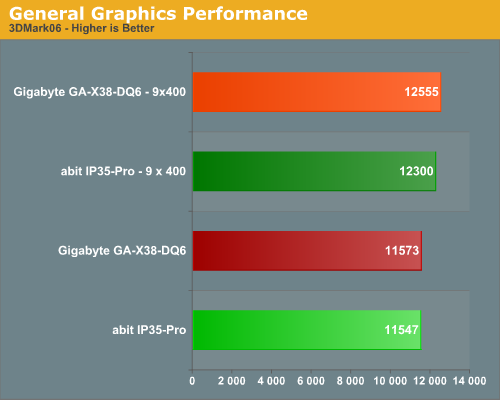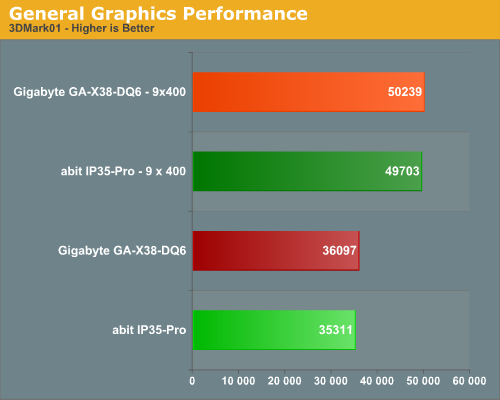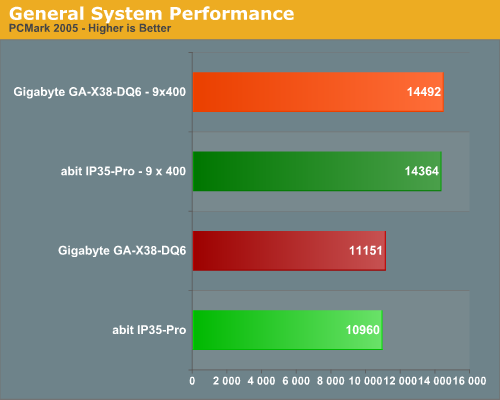Gigabyte GA-X38-DQ6: An early look at X38
by Gary Key on September 4, 2007 3:00 AM EST- Posted in
- Motherboards
Synthetic Graphics Performance
The 3DMark series of benchmarks developed and provided by Futuremark are among the most widely used tools for benchmark reporting and comparisons. Although the benchmarks are very useful for providing apple to apple comparisons across a broad array of GPU and CPU configurations they are not a substitute for actual application and gaming benchmarks. In this sense we consider the 3DMark benchmarks to be purely synthetic in nature but still valuable for providing consistent measurements of performance.


In our 3DMark06 test, the X38 and P35 are basically even in this test. The Gigabyte board is around 2% faster when overclocked although this margin is still relatively small. When looking at the individual tests, the Gigabyte board scored slightly better in the SM2.0 and SM3.0 tests while the CPU scores were just about identical when comparing the two chipsets.
In the more memory and CPU throughput sensitive 3DMark01 benchmark we see our Gigabyte GA-X38-DQ6 board about 2% quicker at stock speeds and only 1% when overclocked. The differences in performance are not really noticeable in either 3DMark unless you're looking to reach the top of the ORB, which we have a good feeling the X38 was designed to do with the right setup.
General System Performance
The PCMark05 benchmark developed and provided by Futuremark is designed to measure overall system performance for the typical home computing user. This tool provides both system and component level benchmarking results utilizing subsets of real world applications or programs. This benchmark is useful for providing comparative results across a broad array of Graphics, CPU, Hard Disk, and Memory configurations along with multithreading results. In this sense we consider the PCMark benchmark to be both synthetic and real world in nature and it again provides consistency in our benchmark results.

Our PCMark05 scores mimic the results from our 3DMark benchmarks with differences of around 2% at stock speeds and 1% when overclocked. While this benchmark is designed around actual application usage, we will see if these results mirror our own real-world application testing.
The 3DMark series of benchmarks developed and provided by Futuremark are among the most widely used tools for benchmark reporting and comparisons. Although the benchmarks are very useful for providing apple to apple comparisons across a broad array of GPU and CPU configurations they are not a substitute for actual application and gaming benchmarks. In this sense we consider the 3DMark benchmarks to be purely synthetic in nature but still valuable for providing consistent measurements of performance.


In our 3DMark06 test, the X38 and P35 are basically even in this test. The Gigabyte board is around 2% faster when overclocked although this margin is still relatively small. When looking at the individual tests, the Gigabyte board scored slightly better in the SM2.0 and SM3.0 tests while the CPU scores were just about identical when comparing the two chipsets.
In the more memory and CPU throughput sensitive 3DMark01 benchmark we see our Gigabyte GA-X38-DQ6 board about 2% quicker at stock speeds and only 1% when overclocked. The differences in performance are not really noticeable in either 3DMark unless you're looking to reach the top of the ORB, which we have a good feeling the X38 was designed to do with the right setup.
General System Performance
The PCMark05 benchmark developed and provided by Futuremark is designed to measure overall system performance for the typical home computing user. This tool provides both system and component level benchmarking results utilizing subsets of real world applications or programs. This benchmark is useful for providing comparative results across a broad array of Graphics, CPU, Hard Disk, and Memory configurations along with multithreading results. In this sense we consider the PCMark benchmark to be both synthetic and real world in nature and it again provides consistency in our benchmark results.

Our PCMark05 scores mimic the results from our 3DMark benchmarks with differences of around 2% at stock speeds and 1% when overclocked. While this benchmark is designed around actual application usage, we will see if these results mirror our own real-world application testing.










26 Comments
View All Comments
RamarC - Tuesday, September 4, 2007 - link
THG is crap now. I'm surprised they haven't started 'reviewing' calculators (TI-35X, worth the extra $5?) or some other nonsense.Gamewise, I hope AT replaces HL2 with Bioshock to keep up-to-date. (Practically every video card can break 100fps on HL2.)
JarredWalton - Tuesday, September 4, 2007 - link
Working on Bioshock, although I don't know that I'll drop HL2. Completely different engines, people, even if they're both playable via Steam. Bioshock is Unreal Engine 3, remember, and I think we'll keep using Lost Coast until Episode 2 comes out. Bioshock unfortunately requires the use of FRAPS - or fortunately depending on your perspective? Anyway, it runs surprisingly well at max details and high resolutions... it's not a game that needs 100+ FPS by any stretch. I've played through some of it on an X1900 XT at 2560x1600 and found it to be acceptable, for example.I will be using Bioshock in future laptop articles for sure, as well as any system reviews. I would assume Gary and others will use it as well.
Dismalis - Tuesday, September 4, 2007 - link
I just REALLY hope that Gigabyte will release an X38 combo model with support both DDR2 and DDR3 memory... Just like GA-P35C-DS3R.Do you think that's going to happen?
mostlyprudent - Tuesday, September 4, 2007 - link
Gary,When you said "we found the stability, performance, and compatibility of this early engineering sample to be better than several retails boards we are currently testing" were you refering to other X38 boards, or P35 boards, or what?
JarredWalton - Tuesday, September 4, 2007 - link
Retail non-X38 boards. Probably some of the uATX stuff he's testing, as well as P35, judging by what else he's working on.Vidmar - Tuesday, September 4, 2007 - link
From the pictures we saw from Computex this board had an eSata connector on the back, but now I don't see one. Instead it looks like two firefire ports are there.I do love that they have six USB connectors on the back. It's the one feature that I appreciate on my LanParty nF4 Ultra-D.
I would also love to see a direct comparison between the DDR2 and the DDR3 (GA-X38T-DQ6) version of this board. I wonder if the x38 would make a difference in that area.
Thanks for the preview.
Jodiuh - Tuesday, September 4, 2007 - link
Actually, I think there's 8 USB ports! It's good to see my recent purchase of Abit IP35 Pro will serve my needs well into 2008 too. :D How much longer will we wait for the P35 roundup?strikeback03 - Tuesday, September 4, 2007 - link
Looks to me like there are 4 USB, 4 eSata, 2 RJ-45 and 2 Firewire.Vidmar - Tuesday, September 4, 2007 - link
Hmmm could be now that you mention it. I'm not sure that I could ever find a need for 4 eSata connections.Here is what the board looked like back at Computex:
http://www.anandtech.com/tradeshows/showdoc.aspx?i...">http://www.anandtech.com/tradeshows/showdoc.aspx?i...
Quite a few changes it seems. Gary/Jarred care to enlighten us as to which layout we can expect to see in retail?
Missing Ghost - Tuesday, September 4, 2007 - link
I think you're right.